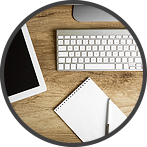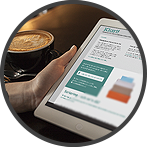A handful of common productivity mistakes and how to avoid them
Datum: 2009-09-09 23:29

Many people that I meet in my profession, says “I really would need that!” when they hear me say that I work with making organizations and individuals more structured in their everyday life.
Often, they seem dejected when they say that, almost like they feel that creating a good personal structure is far too hard for them.
As I see it, it is just as easy to create a great structure as it is to keep a defective structure. It is just a matter of habits and simple tools.
Here are nine common mistakes that prevents good personal structure and tips on how to avoid them. I have made several of the mistakes myself, so I do know what I am talking about here.
Piles
We gather documents, leaflets, printouts and other stuff in high piles on our desk instead of storing them in a well thought-out and easy system for reference material. For example, set up a file folder system in alphabetical order and you will find what you need just as easy as you swiftly store it away.
Scattered notes, post-its and odd bits of paper
We write to-do-tasks on odd bits of paper instead of listing them in a stable and secure system (on paper or by using the computer) which would make it possible to get a lucid view over all our tasks and that would let us relax easily, knowing that everything is taken care of.
Fussy tasks
Writing a to-do-task, we often define it far too general and unspecific when it instead is supposed to be as concrete and detailed that it can be completed within one, single coherent activity. Instead of writing “Recruit Acme as a customer” write “Call Steve at Acme and suggest a meeting in two weeks”.
“I do not have time to improve my productivity right now”
We think that we need more time to start working more effectively and thereby get more time at our disposal for other things. A better way of thinking is to start with a single small change in the right direction, that do not take more than fifteen minutes. Then do another small change and yet another, never stop taking small, small steps in the right direction.
I got into personal productivity ten years ago or so and I am still refining my way of working, and enjoy every new trick I come up with.
We keep everything in our heads
We make to-do-lists but do not add new urgent tasks; instead we try to keep them in our heads. The to-do-list thereby gets out of date and unimportant (and unused). Instead, let the to-do-list be the only place where you keep track of your tasks. As soon as you notice that you are keeping a task in your head, add it to your to-do-list, unless you complete the task immediately.
We read e‑mails but act later (some other time)
We quickly read through e‑mails without deciding what they mean to us, such as if they contain a yet undefined task, and we keep them in our inbox to be processed at sometime later. Instead, let us make a quick decision the very first time we read the e‑mail. Can we delete it or should we save it? Does it mean that I have to do something? Will I ask someone else to do something?
Storing documents in multiple places
We save e‑mails in customer folders in our mailbox and other documents regarding the same customer on the local hard drive or on the department’s file server instead of collecting all documents regarding a specific customer or project in one, single place irrespective of the format they are created in.
Reminders when we need them the least
We let documents requiring a task that we must not forget lie on our desk so that we won’t forget them (long before we need them), for example invites for seminars, agendas for meetings, offers that we need to reply to before a certain date, instead of sending them to ourselves in the future, using a tickler file (a concept that I will describe in a future edition of Done!).
Crowded computer desktop
We fill the computer desktop with icons for shortcuts and documents instead of creating a folder on the desktop where we place the shortcuts and documents, so that we can easily reach all we need from the desktop as well as, with a single mouse click, closing the folder and clearing the desktop completely (apart from the folder). Having a crowded computer desktop makes it hard to find what you need when you need it and when you don’t need it, you still get reminded of it.
What is your best tip?
Have you done any other mistakes and found a smart way to avoid them in the future? E‑mail me at {encode=“david@stiernholm.com” title=“david@stiernholm.com”} and tell me. I am eager to learn more tips on structure and I might share your experience with others.




